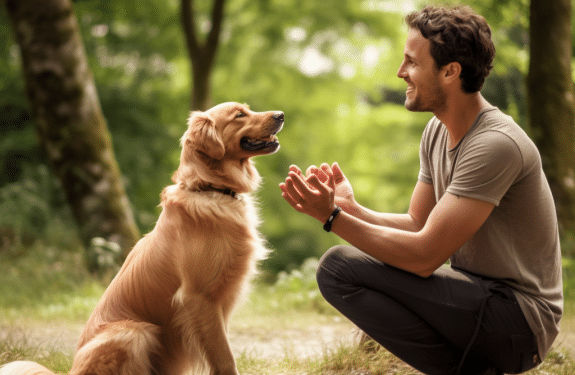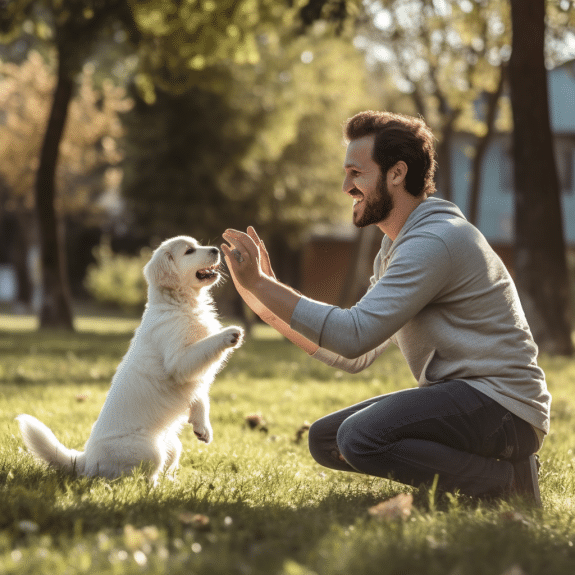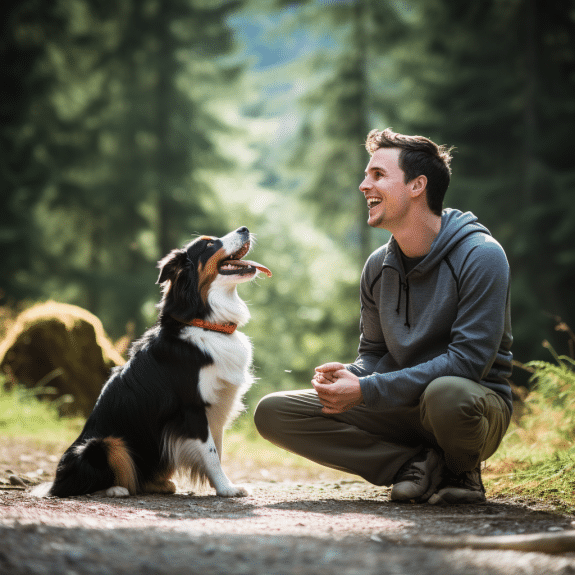Mastering Dog Training: Strategies for Behavioral Harmony

Training can be rewarding yet behaviorally difficult. Training our pets requires overcoming these obstacles. This page discusses US dog training habits.
To fix behavior, identify aggression triggers. Identifying dog aggression triggers allows us to adapt desensitization.
Socialization and favorable experiences reduce behavior problems. Positive social interactions and diverse social situations make canines more well-rounded.
Giving dogs room is another crucial strategy. A secure environment helps reduce stress and behavioral abnormalities during fear or anxiety.
Addressing behavioral difficulties requires consistent training. Dogs thrive on consistency, so clear rules help them understand expectations. Professionals can also advise on severe behavioral concerns.
Behavior issues like dog aggressiveness are widespread. With training and instruction, dogs can control their hostility. Some causes of territorial, protective, terrified, predatory, and misdirected aggression must be addressed.
Aggression warning signs must be recognized for effective intervention. Hostile behavior includes growling, baring teeth, lunging, snapping, charging, and excessive barking. Early detection of these warning signs helps avert aggressive conduct.
The internet has popularized online dog training. Price, convenience, flexibility, customized support, and qualified trainers are offered in these courses. Consider reputation, favorable evaluations, effective and humane training methods, and extensive information when choosing an online dog training school.
Finally, dog training behavioral concerns require multiple approaches. Understanding aggression triggers, desensitization, socialization, positive experiences, giving dogs space, training consistently, and seeking professional help can help us manage behavioral difficulties and bond with our dogs.
Understanding Behavioral Issues in Dogs
Like humans, dogs have behavioral difficulties that need attention and resolution. Dogs, like people, have personalities and tendencies that can be difficult to comprehend and handle. Dog owners and trainers must grasp these behavioral concerns to train and manage their pets.
Dogs’ behavioral issues might be caused by fear, anxiety, pain, possessiveness, and dominance. One typical behavioral issue is aggression, which can include growling, baring teeth, lunging, snapping, charging, and excessive barking. Aggression can be provoked by other canines, people, or events. Aggression triggers must be identified to develop effective measures to change the behavior.
Desensitization can help with behavioral issues, especially aggression. Slowly and positively exposing the dog to the aggressive trigger is used in these methods. Slowly and methodically introducing the trigger and rewarding calm behavior might help the dog associate it with happy experiences, reducing aggression.

| Types of Aggression | Common Triggers |
|---|---|
| Territorial Aggression | Protecting their territory or resources |
| Protective Aggression | Guarding their family or possessions |
| Fearful Aggression | Feeling threatened or scared |
| Predatory Aggression | Pursuing smaller animals or prey instincts |
| Redirected Aggression | Redirecting frustration or aggression towards a different target |
While it is essential to address and modify behavioral issues, it’s important to note that there is no “cure” for dog aggression. However, with proper training and management, dogs can learn to control their aggressive behavior and live harmoniously with humans and other animals. Seeking professional help from experienced trainers and behaviorists can provide invaluable guidance and support in dealing with complex behavioral challenges.
Identifying Triggers for Aggression
Aggression in dogs can be a challenging behavioral issue to handle, but identifying the triggers that provoke this behavior is crucial for effective training and management. By understanding what triggers aggression in dogs, pet owners and trainers can develop strategies to prevent or minimize the occurrence of aggressive behaviors.
Common triggers for aggression in dogs include fear, territoriality, resource guarding, frustration, and social or environmental stressors. It is essential to closely observe a dog’s behavior and identify patterns in their aggressive responses. Sometimes, triggers can be specific objects, situations, or even certain individuals that elicit a defensive or protective response in the dog.
Identifying the triggers for aggression requires careful observation and documentation. Keeping a detailed log of the dog’s aggressive episodes and noting the circumstances surrounding them can provide valuable insights into the specific triggers. Consulting with a professional dog trainer or behaviorist can also be beneficial in accurately identifying and addressing the triggers for aggression.
Once the triggers are identified, steps can be taken to modify the dog’s response and behavior. This may involve desensitization and counterconditioning techniques, where the dog is gradually exposed to the trigger in a controlled and positive manner. Additionally, providing a safe and enriched environment, addressing any underlying medical issues, and implementing consistent training methods can all contribute to managing and reducing aggression in dogs.
| Common Triggers for Aggression in Dogs | Description |
|---|---|
| Fear | Dogs may exhibit aggression when they feel threatened or scared. |
| Territoriality | Protective behavior towards their perceived territory or personal space. |
| Resource guarding | Dogs may display aggression when protecting their food, toys, or other valuable resources. |
| Frustration | When dogs are unable to access or achieve something they desire, aggression may manifest. |
| Social or environmental stressors | Unfamiliar or overwhelming social situations, loud noises, or excessive stimuli can trigger aggression. |
Desensitization Techniques
In dog training, desensitization techniques are crucial for overcoming behavioral challenges, especially when dealing with aggression. Desensitization involves exposing the dog to the trigger that elicits the unwanted behavior in a controlled and gradual manner, with the goal of reducing the dog’s sensitivity and fear response.
One effective desensitization technique is counter-conditioning, where the dog is conditioned to associate the trigger with something positive, such as treats or praise. This helps to replace the fear or aggression response with a more positive and relaxed behavior.
Another desensitization technique is systematic desensitization, which involves exposing the dog to gradually increasing levels of the trigger, starting from a point where the dog feels comfortable and relaxed. This helps the dog build tolerance and reduces the likelihood of an aggressive or fearful response.
Desensitization Techniques for Aggression
- Identify the triggers: Before starting desensitization, it’s important to identify the specific triggers that cause the aggressive behavior in your dog. Common triggers can include unfamiliar people or animals, loud noises, or certain environments.
- Create a desensitization plan: Once you have identified the triggers, create a plan that outlines the gradual exposure process. Start with a low-intensity version of the trigger and gradually increase the intensity as your dog becomes more comfortable.
- Use positive reinforcement: During the desensitization process, reward your dog with treats, praise, and affection when they exhibit calm and non-aggressive behavior in the presence of the trigger. This helps to reinforce the positive association with the trigger.
- Be patient and consistent: Desensitization takes time and consistency. It’s important to be patient with your dog and maintain a consistent training schedule. Gradually increase the difficulty level as your dog progresses.
By incorporating desensitization techniques into your dog training routine, you can help your dog overcome behavioral challenges, particularly in managing aggression. However, it’s important to remember that desensitization should always be done under the guidance of a professional dog trainer or behaviorist to ensure the safety and well-being of both you and your furry friend.
| Desensitization Techniques for Aggression | Benefits |
|---|---|
| Counter-conditioning | – Replaces fear or aggression response with positive behavior – Builds a positive association with the trigger |
| Systematic desensitization | – Gradually exposes the dog to increasing levels of the trigger – Builds tolerance and reduces fear response |
Socialization and Positive Experiences
Socialization plays a vital role in shaping a dog’s behavior and overall well-being. By exposing dogs to various people, animals, environments, and experiences, we can help them develop into confident, well-adjusted companions. Positive experiences during socialization can lay the foundation for a dog’s ability to navigate the world with ease and reduce the likelihood of behavioral challenges.
During the critical socialization period, which typically occurs between 3 to 14 weeks of age, puppies are most receptive to new experiences. This is an ideal time to introduce them to different sights, sounds, and stimuli in a positive and controlled manner. By gradually exposing puppies to a variety of environments, such as busy streets, parks, and different household settings, we can help them become more comfortable and less fearful in new situations.
Positive experiences should also extend to interactions with humans and other animals. Encouraging gentle play and supervised interactions with well-socialized dogs can help puppies develop appropriate social skills and reduce the likelihood of aggression or fear-based behaviors. Ensuring that encounters are positive, with rewards, praise, and pleasant experiences, can create positive associations that contribute to a well-rounded and emotionally stable adult dog.
Socialization Tips:
- Expose your puppy to a variety of people, including individuals of different ages, appearances, and ethnicities.
- Regularly introduce your puppy to other well-socialized dogs in controlled environments to promote positive social interactions.
- Gradually expose your puppy to different environments, such as crowded streets, parks, and car rides, to help them become comfortable in various situations.
- Utilize positive reinforcement techniques, such as treats, toys, and praise, to reward your puppy for calm and confident behavior during socialization experiences.
“Proper socialization and positive experiences during a dog’s early developmental stages are crucial for their long-term emotional well-being and behavior. By providing a wide range of positive social interactions and exposure to new environments, we can help them grow into confident, well-adjusted individuals who can navigate the world with ease.”
| Benefits of Socialization and Positive Experiences | Examples |
|---|---|
| Reduced fear and anxiety | A dog who has been exposed to different environments and social situations is less likely to develop fear-based behaviors. |
| Improved social skills | Dogs who have positive interactions with humans and other animals during their formative years are more likely to have better social skills and reduced aggression. |
| Enhanced adaptability | Exposure to various stimuli and experiences helps dogs build resilience and adaptability, making it easier for them to handle new situations throughout their lives. |
| Reduced risk of behavioral challenges | Proper socialization and positive experiences significantly decrease the likelihood of behavioral issues, such as fear aggression, separation anxiety, and excessive barking. |
Giving Dogs Space
Creating a safe and comfortable environment for dogs is crucial when dealing with behavioral challenges. One effective strategy that can be employed is giving dogs space. Providing them with their own designated area or retreat allows them to have a sense of security and helps alleviate any feelings of fear or anxiety.
Having a designated space also helps establish boundaries, which is particularly important in cases where a dog may be exhibiting aggressive behavior. By giving dogs their own space, they have a place to retreat to when they feel overwhelmed or need a break, reducing the likelihood of escalation.
It is essential to ensure that the designated space is quiet, free from potential triggers, and equipped with comfortable bedding and toys. This helps create a positive association and a safe haven for the dog. Additionally, providing mental stimulation through interactive toys can help divert their attention from challenging behaviors and redirect their focus onto positive experiences.
The Benefits of Giving Dogs Space:
- Reducing stress: Giving dogs their own space helps reduce stress levels by providing a sanctuary where they can relax and feel secure.
- Promoting calm behavior: Having a designated area encourages dogs to exhibit calm behaviors, as they have a place to retreat to when feeling anxious or overwhelmed.
- Establishing boundaries: Dogs learn to respect boundaries when they have a designated space, which can help manage any aggressive tendencies and create a safer environment for everyone.
“Giving dogs space not only provides them with a sense of security but also gives them the opportunity to decompress and regulate their emotions.” – Professional Dog Trainer
| Benefits | Examples |
|---|---|
| Reduced stress levels | A dog having a designated space to retreat to when feeling overwhelmed. |
| Promotion of calm behavior | A dog exhibiting relaxed and content behavior while in its designated space. |
| Establishing boundaries | A dog learning to respect boundaries and exhibiting improved behavior due to having its own space. |
Consistency in Training
Consistency is a fundamental aspect of successful dog training. It creates a structured environment that helps dogs understand and learn desired behaviors more effectively. By following consistent training methods, dog owners can establish clear boundaries, reinforce positive behaviors, and address behavioral challenges in a systematic manner.
One key aspect of consistency in training is establishing a routine. Dogs thrive on predictability, and a consistent daily schedule provides them with a sense of security. From feeding times to exercise routines and training sessions, sticking to a set schedule helps dogs understand what is expected of them and reduces confusion and anxiety.
Benefits of Consistency in Training
Consistency in training also helps create a strong bond between the dog and the owner. When owners consistently provide clear communication and reinforce desired behaviors, dogs feel more secure and confident in their role within the family. This, in turn, leads to more harmonious relationships and a higher success rate in overcoming behavioral challenges.
“Consistency is key in dog training. It sets clear expectations and helps dogs understand what is acceptable behavior. The more consistent we are as owners, the more successful our training efforts will be.” – Professional Dog Trainer
Table: Consistency in Training Techniques
| Technique | Description |
|---|---|
| Reward-based training | Consistently rewarding desired behaviors with treats, praise, or playtime reinforces positive behavior and encourages dogs to repeat those behaviors. |
| Clear commands | Using consistent verbal cues and hand signals helps dogs understand what is expected of them and facilitates effective communication. |
| Consistent rules | Establishing and enforcing consistent rules in the household helps dogs understand boundaries and promotes good behavior. |
| Consistent consequences | Applying consistent consequences, such as time-outs or a firm “no” when undesirable behaviors occur, helps dogs learn what is not acceptable. |
Consistency in training is a powerful tool in overcoming behavioral challenges in dogs. By establishing a routine, reinforcing positive behaviors, and using consistent training techniques, dog owners can create an environment that promotes learning and sets clear expectations. With patience and dedication, consistent training can help dogs overcome behavioral challenges and become well-behaved, happy companions.
Seeking Professional Help
Professional aid may be needed to solve difficult canine behavioral issues. Professional trainers or behaviorists are needed for aggression training, however dog owners can train general obedience. These experts can identify a dog’s behavioral issues and create a customized training plan.
Working with professionals can help uncover dog aggression triggers. By knowing what triggers a dog’s aggression, trainers can build targeted techniques to change their behavior. Professional trainers can assist dogs overcome aggression due to fear, anxiety, pain, possession, or dominance.
Consistent training also requires professional trainers. They may help owners realize the value of consistency in training and recommend ways for each dog. Having a professional can help overcome behavioral issues because consistency is crucial to rewarding positive behaviors and discouraging bad ones.
| Benefits of Seeking Professional Help |
|---|
| Expert assessment of behavioral challenges |
| Tailored training plans |
| Identification of triggers for aggression |
| Development of desensitization strategies |
| Guidance on consistent training techniques |
Aggression and Training
Aggression is a common behavioral challenge that many dog owners face. However, with proper training and management, dogs can learn to control their aggression and become well-behaved and obedient companions. Training plays a vital role in addressing aggression and shaping a dog’s behavior, providing them with the necessary skills to navigate social situations and interactions.
One effective approach to training dogs with aggression is through positive reinforcement. By rewarding desirable behaviors and ignoring or redirecting undesirable ones, dogs learn to associate good behavior with positive outcomes. This helps them understand that calm and controlled behavior is more rewarding than aggression. Additionally, incorporating obedience commands such as sit, stay, and leave it into training sessions can give dogs a sense of structure and guidance, further reducing their aggression.
It is important to note that aggression should not be met with punishment or physical force, as this can exacerbate the issue and lead to more aggressive behavior. Instead, training methods that focus on building trust, establishing clear boundaries, and providing consistent guidance are key to addressing aggression effectively.
Training Techniques to Manage Aggression:
- Socialization: Exposing dogs to a variety of people, animals, and environments at an early age can help them develop positive associations and reduce fear-based aggression.
- Desensitization: Gradually exposing dogs to their triggers in a controlled and positive manner can help them overcome their fear or anxiety and reduce aggressive reactions.
- Counterconditioning: Pairing the presence of the trigger with something the dog enjoys, such as treats or playtime, can help change their emotional response and reduce aggression.
Remember, addressing aggression requires patience, consistency, and professional guidance when necessary. With the right training techniques and a commitment to positive reinforcement, dogs can learn to manage their aggression and thrive as well-behaved companions.
| Training Technique | Description |
|---|---|
| Socialization | Exposing dogs to various people, animals, and environments to reduce fear-based aggression. |
| Desensitization | Gradually exposing dogs to triggers in a controlled and positive manner to reduce aggressive reactions. |
| Counterconditioning | Pairing the presence of triggers with something dogs enjoy to change their emotional response and reduce aggression. |
Types of Aggression
Aggression in dogs can manifest in various forms, including territorial, protective, fearful, predatory, and redirected aggression. Understanding these types of aggression is crucial for trainers and dog owners to effectively address behavioral challenges.
Territorial aggression occurs when a dog becomes possessive and protective over its territory, such as the home or yard. Dogs exhibiting territorial aggression may bark, growl, and show aggression towards unfamiliar people or animals encroaching on their perceived territory.
Protective aggression is similar to territorial aggression but can extend beyond the immediate surroundings. Dogs with protective aggression may show aggression towards family members or individuals they perceive as a threat to their pack or resources.
Fearful aggression arises from a dog’s fear or anxiety towards certain situations, people, or objects. Dogs experiencing fearful aggression may exhibit submissive or defensive behaviors such as cowering, trembling, or trying to escape. In an attempt to protect themselves, they may resort to aggression when they feel cornered or threatened.
Predatory aggression is instinctual and often seen in dogs with a high prey drive. Dogs displaying predatory aggression may chase, lunge, or bite at moving objects, such as small animals or even children. This type of aggression requires careful management and training to prevent potential harm.
Redirected aggression occurs when a dog becomes frustrated or overstimulated and redirects its aggression towards a nearby person or animal. This can happen when the dog is unable to reach the initial target of its aggression. Redirected aggression can be unpredictable and potentially dangerous.
By understanding the different types of aggression, trainers and dog owners can tailor their approaches to effectively address behavioral challenges. Remember that aggression is a complex issue with various underlying factors, and seeking professional help is often necessary to ensure the safety and well-being of both the dog and those around them.
Warning Signs of Aggression
Dog owners must recognize aggression indicators to protect their canines and others. Dogs express emotions and intentions through body language, vocalizations, and behavior. Knowing these warning signs lets you avoid risky situations.
Aggression is often indicated by growling. A growling dog is clearly feeling threatened or uncomfortable. Another symptom of hostility is bare teeth. Dogs may snarl or lift their lips to exhibit their teeth.
Dogs can also become aggressive by lunging, snapping, charging, and barking. These actions frequently involve stiff posture, increased fur, and a stare-down. To deescalate the situation, pay attention to these warning signs and respond immediately.
Understanding a dog’s aggression’s causes is crucial. Aggression can result from fear, anxiety, pain, possession, or dominance. Identification allows training and behavior modification to address the root problem.
| Type of Aggression | Description |
|---|---|
| Territorial Aggression | A dog displays aggression when it feels its territory is being threatened. |
| Protective Aggression | A dog exhibits aggression when it perceives a threat to its family members or resources. |
| Fearful Aggression | A dog acts aggressively when it feels frightened or threatened. |
| Predatory Aggression | A dog displays aggression when it’s in a hunting mode or chasing after prey. |
| Redirected Aggression | A dog redirects its aggression towards something or someone else due to frustration or arousal. |
Being able to identify these warning signs and understand the different types of aggression plays a crucial role in dog training and management. It allows dog owners to take proactive steps to prevent aggressive incidents and keep everyone safe.
The Benefits of Online Dog Training Courses
Online dog training courses have gained immense popularity in recent years, offering numerous advantages to dog owners and trainers. These courses provide a convenient and affordable way to access professional training from the comfort of your own home. With personalized support and flexible scheduling, online dog training courses offer a range of benefits for both dogs and their owners.
One of the key benefits of online dog training courses is affordability. Traditional in-person training can be costly, requiring regular sessions with a professional trainer. Online courses, on the other hand, often offer comprehensive training programs at a fraction of the cost. This cost-effectiveness allows dog owners to access high-quality training without breaking the bank.
Convenience is another major advantage of enrolling in online dog training courses. With the ability to watch instructional videos and participate in training exercises from anywhere with an internet connection, owners can fit training sessions into their busy schedules. This flexibility ensures that training becomes a consistent and ongoing process, leading to more effective behavioral changes in dogs.
Furthermore, online dog training courses provide personalized support from experienced trainers. Many online programs offer forums and Q&A sessions where participants can interact with trainers and fellow dog owners, addressing specific challenges and receiving guidance tailored to their dog’s needs. This personalized approach enhances the learning experience and allows for more efficient problem-solving.
| Benefits of Online Dog Training Courses |
|---|
| Affordability |
| Convenience |
| Personalized Support |
| Flexibility |
Choosing the Right Online Dog Training Course
Choosing the correct online dog training course is essential for success and resolving behavioral issues. Due to the popularity of online education, there are many possibilities, making it important to choose one that suits your needs and aspirations.
Consider repute and positive ratings while picking an online dog training course. Select courses with high ratings and excellent participant feedback. This will show the course’s legitimacy and ability to teach the relevant skills and practices.
Effective and humane training methods are also necessary. Find courses that promote positive reinforcement and compassionate handling. Avoid harsh or punishment-based courses that might harm your dog and increase behavioral disorders.
Assessing comprehensive content is also important. An effective online dog training course should address fundamental obedience, problem-solving, and behavioral issues. Make sure the course includes step-by-step instructions and real-world tasks.
| Course Name | Benefits |
|---|---|
| K9 Training Institute | – Access to professional trainers – Customized support – Affordable pricing – Flexible learning schedule |
| Spirit Dog Training | – Experienced trainers – Positive reinforcement-based techniques – Interactive lessons – Comprehensive course material |
Top 2023 online dog training courses include K9 Training Institute and Spirit Dog Training. The K9 Training Institute provides skilled trainers and specialized support to meet your dog’s needs. This course offers dog owners convenience and affordability with a flexible study schedule.
Another recommended training is Spirit Dog Training, with professional trainers who emphasize positive reinforcement. Their informative courses and thorough course material make training principles easy to grasp and apply.
An online dog training course with a good reputation, positive reviews, effective and humane training methods, and comprehensive content can help you and your dog overcome behavioral issues and build a trusting and understanding bond.
Top Online Dog Training Courses for 2023
If you’re looking to enhance your dog training skills with the convenience and flexibility of online courses, you’ll want to explore the top options available in 2023. Two standout choices are the K9 Training Institute and Spirit Dog Training.
K9 Training Institute
The K9 Training Institute offers a comprehensive online dog training program designed to address a wide range of behavioral challenges. With a team of experienced trainers, they provide personalized support to help you navigate the training process effectively.
- Course: Basic Obedience Training
- Duration: 8 weeks
- Benefits:
- Comprehensive curriculum covering basic obedience commands
- Interactive video lessons
- Live Q&A sessions with trainers
- Access to a private online community for additional support
- Certificate of completion
- Price: $199
Spirit Dog Training
Spirit Dog Training is another top choice for online dog training courses. Their unique approach combines positive reinforcement techniques with a focus on building a strong bond between dogs and their owners. The courses are designed to address behavioral challenges and promote overall well-being.
- Course: Behavior Modification for Fearful Dogs
- Duration: 6 weeks
- Benefits:
- Step-by-step guidance on helping fearful dogs overcome their anxieties
- Video demonstrations of training techniques
- Access to a supportive online community
- Personalized feedback on training progress
- Price: $149
Both the K9 Training Institute and Spirit Dog Training are reputable online platforms that offer effective solutions for overcoming behavioral challenges in dog training. Whether you’re a beginner or an experienced trainer, these courses can provide valuable insights and strategies to improve your training techniques and strengthen the bond with your furry companion.

| Training Institute | Course | Duration | Benefits | Price |
|---|---|---|---|---|
| K9 Training Institute | Basic Obedience Training | 8 weeks | Comprehensive curriculum, interactive video lessons, live Q&A sessions, access to online community, certificate of completion | $199 |
| Spirit Dog Training | Behavior Modification for Fearful Dogs | 6 weeks | Step-by-step guidance, video demonstrations, access to online community, personalized feedback | $149 |
Conclusion
Overcoming behavioral challenges in dog training requires a combination of effective strategies, consistency, and sometimes, seeking professional help. By understanding and addressing these challenges head-on, dog owners can create a harmonious and well-behaved furry companion.
Identifying the triggers for aggression and taking steps to desensitize dogs to them is crucial. Socialization and providing positive experiences play a significant role in mitigating behavioral challenges. Giving dogs space, especially in cases of fear or anxiety, can help alleviate their stress.
Consistency in training is key to reinforcing desired behaviors and overcoming behavioral challenges. Seeking professional help when needed can provide expert guidance and support in dealing with complex issues.
Aggression is a common behavioral challenge in dogs, but proper training and management can help them control their reactive behavior and live peacefully with others. Understanding the reasons behind aggression, such as fear, anxiety, pain, possession, or the need for dominance, is essential in addressing and managing it.
There are different types of aggression, including territorial, protective, fearful, predatory, and redirected aggression. Recognizing the warning signs of aggression, such as growling, baring teeth, lunging, snapping, charging, and barking, is crucial in addressing and preventing potential aggressive behaviors.
Online dog training courses provide valuable resources for dog owners, offering affordability, convenience, flexibility, personalized support, and access to professional trainers. When choosing a course, it’s important to consider their reputation, positive reviews, effective and humane training methodologies, and comprehensive content.
In 2023, the top online dog training courses to consider are the K9 Training Institute and Spirit Dog Training. These courses have proven track records in helping dog owners overcome behavioral challenges and establish a well-behaved and happy canine companion.
FAQ
How can I overcome behavioral challenges in dog training?
Overcoming behavioral challenges in dog training requires identifying the trigger for aggression and taking steps to desensitize the dog to it. Socialization, positive experiences, and giving the dog space are key strategies. Consistency and seeking professional help when needed are also important.
Is there a cure for dog aggression?
While there is no “cure” for dog aggression, proper training and management can help dogs control their aggression. Reactive dogs can be trained to live peacefully with other dogs.
What are the reasons why dogs become aggressive?
Fear, anxiety, pain, possession, and the need for dominance are some reasons dogs may become aggressive.
What are the different types of aggression in dogs?
There are different types of aggression, such as territorial, protective, fearful, predatory, and redirected aggression.
What are the warning signs of aggression in dogs?
Warning signs of aggression include growling, baring teeth, lunging, snapping, charging, and barking.
What are the benefits of online dog training courses?
Online dog training courses provide affordability, convenience, flexibility, personalized support, and access to professional trainers.
How do I choose the right online dog training course?
It’s important to choose a course with a good reputation, positive reviews, effective and humane training methodologies, and comprehensive content.
What are the top online dog training courses for 2023?
The top online dog training courses for 2023 include the K9 Training Institute and Spirit Dog Training.




